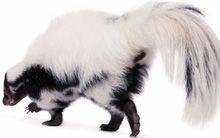A license to cull
A rabid skunk scare in my own backyard tests my veterinary judgment.
My wife interrupted my shower the other night because she thought a skunk had sprayed our dog.
I raced downstairs only to be faced with skunk aroma and our dog cowering with dirt all over his face. This is a familiar scene so I went outside to assess the damage. Six feet away under the patio table was a skunk making himself as big as a puffer fish.

Photo source: Getty ImagesFirst thing, I got my dog inside to check for bite wounds, but all I could find was a small nick on his nose that didn't reach the dermis. It could've been glancing contact with the skunk's nail or tooth, or it may have been unrelated. Also surprising was the fact that the dog didn't have the distinct odor of being directly sprayed-after a bath you couldn't smell the odor on him.
The skunk remained under the patio table. At first I worried that he had a foot stuck in the umbrella stand, but when I went outside again he retreated enough for me to see that all his feet were free. After an hour, he was gone from the patio table, but my 7-year-old son (who was up with the commotion, wouldn't go back to sleep and decided to make good use of his flashlight) found him under the children's picnic table. The skunk stayed there for another hour. By midnight there was no trace of him.
My first thought when I found him was rabies-skunks are the leading carrier in my area. But the entire time he was on the patio he never showed aggression.
My dog doesn't have the killer instinct. He does enjoy the chase, and even at 11 years old he can channel his inner gazelle when he chases a groundhog or squirrel. It's possible that he may have given chase and even surprised himself when he landed on the skunk. Injured, the skunk may have taken refuge under the table, unable to run.
If the skunk had shown aggression, we would've taken the necessary steps to protect ourselves and submitted the skunk's brain for rabies testing. However, based on the presentation, I wasn't sure if action was required. My dog is up to date on his rabies vaccine, and I brought him to work the next day for a booster. I'm not even sure if the lesion was deep enough for the virus to enter.
Regardless, rabies is nothing to take lightly. I now have a better story to tell the next client who asks if a rabies vaccine is necessary. I can control the well-being of my dog, but what about the skunk?
In the veterinarian's oath we swore to work for “the prevention and relief of animal suffering, the conservation of animal resources, the promotion of public health.” If this skunk has rabies, he needs to be culled to end animal suffering and promote public health. If this skunk just had a soft tissue injury or is a passive adolescent, then he should be left alone to conserve animal resources. So I thought it was best to leave things be, let the neighbors know and, if more suspicious behavior develops in the next 10 days, then further action is needed. Otherwise, I'll leave the skunk hunts to the overzealous dentists that can't afford to go lion hunting in Zimbabwe.
Dr. Andy Rollo is an associate at Madison Veterinary Hospital outside of Detroit, Michigan. He is also a Veterinary Economics Editorial Advisory Board member.